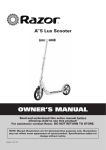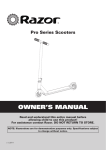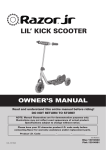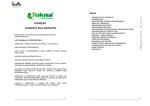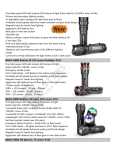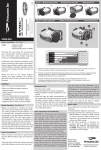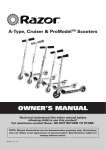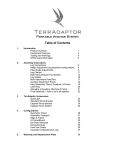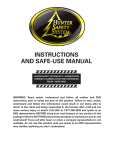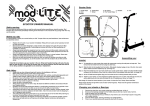Download Submerge Scooters Users Manual WARNINGS: Submerge
Transcript
Submerge Scooters Users Manual WARNINGS: Submerge recommends a DPV course from a certifying SCUBA agency before diving with a scooter. Keep all body parts away from the propellers. Be aware the scooter/propellers may switch on at any time the batteries are connected. Do not get into a situation were a run away scooter could be dangerous. Always obey recommended ascent rates. Always be prepared to cut away from the scooter in any emergency, for example flooded or stuck on scooter. (A flooded scooter may be 50 pounds/25Kg negative or more.) Do not leave your scooter unattended. Batteries off gas explosive hydrogen. Ensure the battery compartment is fully ventilated before connecting the scooter. Store scooter with lid o-ring removed. If the motor compartment becomes wet, the hydrogen catalyst must be replaced before re-using the scooter to prevent possible explosion. Do not short circuit the batteries. Disconnect batteries before attempting any maintenance. UV scooters are not life support equipment and should not be used as such. DO NOT spray any substance into the motor compartment. It must be kept dry. DO NOT spray aerosols into the scooter, as the gas may explode. If a spray is accidentally used, remove batteries from hull do not re-assemble until any gas or residue has evaporated or dried. Disconnect the batteries as soon as practicable after the dive to prevent unintended activation. Remove the jumper cable between the 2 batteries if the batteries are shipped, to prevent a short circuit should the positive and negative wire get crushed together. Caution: Never run the motor more than a few (3) seconds out of the water. Doing so may damage the rear shaft seal. (squeaking sound may be heard while running the seal when dry, as the seal is not designed to run out of the water) Never run the scooter batteries completely down. Sealed lead acid batteries are recommended to be used up 70% of the charge to maintain long life. With lead acid scooters, try not to run the scooters once it becomes noticeable slow. Store out of UV light. HEAT KILLS BATTERIES keep batteries below 110 F That means don't leave the scooter sitting in the sun on a hot day, or in the trunk of a car ect. Always obey recommended ascent rates with the scooter. Do not lift the scooter from the handle. Lift from the shroud or directly from one of the shroud supports. Do not over-tighten any fasteners going into plastic. ¼ turn past finger tight is usually sufficient. Use care to protect o-ring surfaces. Damage is not covered by warranty and repair may not be possible. Be especially careful of the o-ring surface on the end of the hull which is vulnerable when dis-assembled, for instance when charging. Pre-dive: Before the first dive, familiarize yourself with the operation of the mechanical speed control. With the battery dis-connected, lay the scooter on a table, and face the propellers towards you. Hold any propeller blade with 1 hand, and hold and rotate the pitch adjustment knob which is located in the middle of the 3 propeller blades. There are 9 marked speeds, however the knob can be adjusted to any position, for infinite speed control between slow cruise and full speed. Once in the water, start off on speed #3. When replacing the nose cone, ensure nothing obstructs its full insertion. There is a 1" perimeter on the top bulkhead that contacts the nose cone; this is where objects may prevent to correct sealing of the scooter. Place the nose cone on, press it down with hand pressure; there should be no air gaps all the way around the 0-ring BEFORE the spring clips are engaged. Make sure all spring clips are engaged; if 1 or more spring clips are unclipped the scooter will leak. For cave dives or whenever you want more confidence that the batteries are holding a full charge, a resister (burn tester) is available from Submerge to simulate motor current draw. It is recommended to only connect the scooter immediately before the dive, to prevent the accidental activation of the propeller, which could cause injury and also cause the rear seal to burn out and leak. Dive: The scooter is simple to operate, but may take some practice to hone technique. A DPV class is recommended. Only the fingertips of 1 hand should be required for all but drastic direction changes, when the edge of the prop shroud may need to be gripped. The scooter tow-rope is most comfortable if attached to a 2" wide crotch strap which is attached to the backplate or the back of your diving rig. It is important to use a crotch strap attached the back of the harness/rig for best results; attaching to waist strap without a crotch strap will tend to pull your rig over your head. The biggest mistake made with the tow-behind scooters is having the scooter too close to the diver. This results in slow speeds, short burn times, entanglement with other equipment, and an uncomfortable ride. For the best results, the scooter should be as close to a full arms length away as possible. If you are fighting the scooter, you are doing something wrong. The body and cylinders should be in a horizontal position, the head should be fully tilted back to see ahead. Fins should be level with or better yet above the chest level, with no downward force on the fins. The thrust from the propellers must pass below or to the side of the diver without hitting either the diver or any equipment such as stage cylinders, lights, gauges for best results. (Cylinders hung from the right hand side will reduce speed and range, up to 4 cylinders can be comfortable hung from the left hand side if they are aluminum). It is important to be neutrally buoyant at all times, otherwise the scooter power is being wasted maintaining your position in the water column. It is also very difficult to scooter on the surface, as you can't maintain correct body position. If you find yourself facing a long scooter it is always best to take a compass heading and scooter a few feet underwater. Remember that strong currents may only extend 20-30 feet from the surface so descending below this level may enable you to scooter much faster. We start with a 8' length of tow rope and shorten to size. We use a sliding knot which can be adjusted without having to tie underwater can save time when adjusting the tow rope. We use a prussic knot or the similar taught-line hitch as used to adjust tent peg ropes. It is also important to have the clip on the tow rope sliding; when turning left and right the tow rope changes length. If the clip is tied off the scooter will be very difficult to control. The variable pitch mechanism can be adjusted by stopping, gripping a prop in 1 hand and turning the hub with the other. Clockwise is for higher speed. Some props can be adjusted by a quick twist with one hand. For best results, especially with the high performance motors as used in Submerge scooters, it is recommended to slightly de-pitch the props, usually ¼ to ½ turn back from full pitch to # 5 to #7 is effective. Testing has shown that the props are least efficient at full pitch. De-pitching by to #5 to 7 has been shown to lower current draw by as much as 30% with less than 5% drop in speed. CAUTION: Full speed #9 pitch is intended for short periods only. Be especially cautious of using #9 pitch if you have a lot of drag, for instance more than 1 stage or towing another diver. #5 pitch is the most efficient combination of speed and range/burntime. Running the props at full pitch for long periods with a heavy equipment load will result in short burn times. If you need to drop your scooter, or whenever you are not scootering such as deco, it is important to de-pitch the props to #1 position, and lock the trigger. (Pre-2002 scooters do not have a drilled hole in the trigger mechanism to enable the thumb screw to be fully inserted and mechanically lock off the trigger, this is an easy fix with a drill and a ¼" drill bit) Failure modes: Although Submerge Relays and Reed switches underwent extensive testing in 2001 to virtually eliminate the traditional "stuck on" failure of Tekna scooters, it is still good practice to assume the scooter may stop completely or stick and or switch on at any time. If you are scootering through a dangerous area, it is safer to completely de-pitch the props and either leave the scooter or swim through the area than leaving the props pitched up. In the event of a run-away (stuck on) scooter, most divers simply either run the scooter until deco is over, or tie it off. Then simply dis-connect as soon as you get out of the water. Once the shaft seal is wet, it can run for several minutes without damage so don't worry about damaging the seal in this situation. If you wish to slow down with a run-away scooter, practice positioning your body vertically and directing the prop wash directly at your chest. This will virtually stop you completely. Just be sure not to pull it too close to your body or you may entangle equipment in the prop. Also effective to slow a run-away scooter is to push your palm against the pitch adjusting knob; this will de-pitch the props to #1 position. Practice this before you need it. Another procedure which is rarely required, (as the above procedure is so effective) is to grip the spinning prop blades with your hand. The prop will then slip on the clutch plate, but you will be able to de-pitch the props to #1 position making the scooter much easier to handle. The same technique can be used to increase speed after you have regained control at the slowest pitch. A sticking on scooter may be caused by the magnet switch being jammed, so check this first. If this is not the problem, it is either a reed switch or relay failure which can't be fixed underwater. See trouble shooting section. It is important to keep fishing line and other entanglements away for the rear shaft seal. Failure to do so will result in the compromise of the rear shaft seal, and motor flooding. Should the motor flood in salt water, remove the motor from the scooter, rinse with fresh water then soak in mineral spirits. Ship back to Submerge for service. Post-dive: It is recommended to dis-connect scooter as soon as is practical after the dive, to prevent possible damage and personal injury from moving parts. This is easy with the UV scooter as the connector is in the nose. The UV scooters are constructed with corrosion resistant materials, however care must be taken after every dive (especially in salt water) to prevent electrolysis, a form of corrosion between dissimilar materials. Particular care must be taken of the rear shaft area, as the shaft is vulnerable to corrosion if salt water is allowed to remain in the rear hub assembly between dives. If there is no moisture present, there will be no electrolysis. After each dive, it is recommended to soak the back end of the scooter in fresh water, preferably for an hour or more. Running the props in fresh water with the pitch tuned down also helps flush salt water from the hub assembly. After the soak, the hub can be squirted with a small amount of a water dispersing spray such as WD-40(tm). There is a slot in the hub which will allow the water dispersing spray to be applied directly onto the spring washer assembly, which is inside the hub of the propeller assembly. If time and facilities are limited a good rinse with fresh water concentrating on the hub/shaft area followed by a squirt of WD-40 will suffice. Trouble shooting and maintenance notes NEVER USE THE PITCH /PROP NUMBERS TO COMPARE SCOOTER SPEEDS! The pitch adjustment knob can be installed in several different ways, making any comparison useless. The best way to compare speeds is to adjust both scooters to full speed, PROVIDED each scooters propellers can achieve full pitch (see below) Slow scooter: check for correct position of pitch adjustment knob. The correct position is when the scooter only just moves forward when the pitch is on #1 (an important safety feature) and the props do not "bind up" when they are set to the #9 position. In the #9 position, the props should never be tight against the hub, or require extra force to turn the last ¼ turn. Water in the battery compartment may be due to the nose cone being obstructed from full insertion. Be sure the o-rings touch both hull and nose/tail cone before the clips are engaged. What appears to be droplets of water in the hull may be battery acid. Acid can be checked for/neutralized by a paste made of baking soda and water. Acid will foam up. The batteries must both be replaced, even if only 1 of the batteries leak. It is normal so see a very light film of condensation on the motor compartment lid for several hours after a dive. This is caused by the moisture in the air sealed in the motor compartment. Check for a real leak by turning the back end upside down, look for water. If the motor compartment has leaked in fresh water, the relay and hydrogen catalyst must be replaced. The motor can be dried out and re-used if necessary, however it is recommended to ship to Submerge for a check out. Salt water damage is more extensive and the motor must rinsed, soaked in alcohol/ mineral spirits and returned to Submerge for inspection and repair. A sticking scooter is due to reed switch failure or relay failure. Reed switches can be damaged buy short circuiting during service, shock or mechanical damage. Also, only Submerge approved relays can be used as off the shelf relays may expose the reed switch to very high voltages. Motors should never get hot, only warm to the touch. A motor that gets hot should be checked at Submerge to prevent further damage. It is not necessary to grease the large end cap o-rings, however a regular application of a very light coating of grease does not tend to attract more sand particles than an un-greased O-ring, and can extend the life of the 0-rings. Do not be too concerned if the end cap O-rings show cracks, they have to be really deep cracks before they will ever leak. Replace these at your convenience. Charging for lead acid scooters: Lead Acid Genesis batteries (for NiMH batteries see additional instructions below) If your charger is fitted with a voltage selector switch (overseas shipped scooters) be sure that the charger AC voltage selector is in the correct position. This is on the bottom of the Interacter chargers. 1) Remove nose cone 2) Make sure large individual plug is disconnected (main battery disconnect) 3) Plug charger into charge plug Genesis Batteries are of the absorbed glass mat construction,(AGM) which will can not leak, therefore the orientation of the batteries is not important. When the scooter is charged, unplug from charger, replace lid with the o-ring removed so the hull can have ventilation. Do a top up charge 12-24 hours before the dive. ADDITIONAL INSTRUCTIONS FOR N-19 and NiMH UV scooters 1) To reduce the chance of hydrogen buildup which can lead to the risk of explosion, ensure: Battery pack vent screw(s) is removed at all times (except while diving to waterproof battery pack) 2) DO NOT store scooter in a sealed condition. Either remove hull or remove nose or tail hull o-ring for storage. 3) Always store the scooter with the battery disconnected from the motor section of the scooter. The very small current used by the low voltage cut-off in the motor compartment, could, over several months, fully discharge and possibly over-discharge the battery pack. 4) Always charge the NiMH pack within 48 hours of a dive 5) Always re-charge the NiMH battery every 3 months if kept in long term storage. CHARGING INSTRUCTIONS: FIRST ENSURE THE VOLTAGE SELECTOR SWITCH ON THE CHARGER IS CORRECTLY SET FOR YOUR VOLTAGE (110 or 220) 3 AMP SMART CHARGERS: (supplied from June 2007 onwards) 1) Remove scooter hull starting from the tail end (nose cone can remain on hull) 2) Ensure battery pack vent screw is removed. 3) Disconnect battery pack from motor; plug charger into battery pack 4) Plug charger into outlet and turn on. 5) Solid orange indicates charging. After several hours, a flashing green will indicate "supplemental" charging at a reduced rate. Solid green indicates full charge, and maintenance charge. 6) NiMH batteries have a high rate of self discharge, and MUST be re-charged before use. IT IS NOT RECOMMENDED TO LEAVE PACK CONNECTED TO CHARGER FOR PROLONGED PERIODS (2 days) If the scooter has not been used for 2 to 4 weeks, there may be some voltage depression/memory effect and the batteries must be exercised for return to normal capacity. (See " NiMH memory effect" notes below) 4 AMP CHARGERS: (original scooters up until June 2007) 1) Remove scooter hull starting from the tail end (nose cone can remain on hull) 2) Ensure battery pack vent screw is removed. 3) Disconnect battery pack from motor; plug charger into battery pack 4) Plug charger into outlet and turn on. Red LED should light, followed by the second LED flashing ORANGE. 5) Second LED will flash ORANGE while until battery pack is ready to be charged. (If battery pack was recently discharged (used) the ORANGE light may flash for over 1 hour until the battery pack cools sufficiently to begin charge.) 6) second LED will change to solid ORANGE indicating batteries are charging. This will continue up to 5 hours. 7) Second LED will change to GREEN indication charge is complete. At this time the charger should be turned off. The charger does NOT maintain battery charge level with a trickle charge. 8) before diving, the battery pack must be re-charged (topped off). If the scooter has not been used for 2 to 4 weeks, there may be some voltage depression/memory effect and the batteries must be exercised for return to normal capacity. (See " NiMH memory effect" notes below) NiMH "memory" effect. If NiMH batteries are not used regularly (once every 2 to 4 weeks) there will be a temporary reduction in available capacity. Technically this may not be a true "memory" effect but a voltage depression. Ether way, the result is reduced run times. We have had a few calls from divers who have only had 30 or 40 minutes runtime. After the packs have been "exercised" the full capacity has returned, and along with it 70 to 100 minute run times. To correctly exercise the packs, we recommend the use of our burntester and watts up meter. This way you can cycle the pack until it has returned to the normal capacity. It may take more than 1 cycle, and using the watt's up meter is the only way to accurately determine the status of the pack. The procedure is simple: 1) charge the pack. 2) let pack cool to room temperature (minimum 3 hours, preferably overnight) 3) top off battery pack (re- activate charger) 4) discharge using burntester with low voltage cut-off electronics OR dive scooter until power cuts out 5) Record discharge time ( if no Watt's Up meter) or record A/h if using Watt's Up meter. 6) Wait 24 hours between each burntest; Repeat no more than 3 times. (should recover in less than 4 cycles) Notes: Do not remove the motor end vent screw for storage. Always remove the battery pack vent screw except when diving. It is normal to see condensation inside the battery pack after a dive, and also after charging the batteries. This is humidity in the air cooling on the clear housing when the batteries are hot. If Scooter does not switch on, visually check the fuse (there should be a continuous connection from one side of the fuse to the other). Expected life of NiMH batteries: Whilst it is theoretically possible to achieve hundreds of discharge cycles from NiMH packs (or indeed any re-chargable battery) the expected lifetime of a NiMH (or Lithium) pack is limited to approximately 3 years. During the first 12 months, expect at least a 20% reduction in capacity. If the battery is stored at temperatures below 20 degrees Celsius or 70 degrees F, this will prolong the average life expectancy. Here are some approximated ranges of NiMH expected capacity over a lifetime: 0-12 months: 70 to 100% capacity 12-24 months 60 to 75% capacity 24-36 months 50 to 65% capacity 36 months : end of expected life. (Loss of 50% capacity or more). *UV-18, UV-26, UV-42, UV-37-N and N-19 SALTWATER and Submerge are trademarks of Submerge Inc










